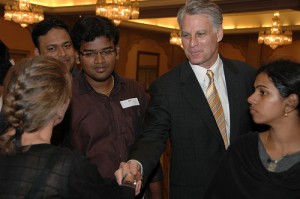 Today we consider nonprofit governance from a community engagement perspective, specifically the make-up and function of the nonprofit board of directors. Most arts administrators understand boards as resource engines. We have a history (understandably) of populating our boards with moneyed people or people who know moneyed people. They clearly represent financial resources.
Today we consider nonprofit governance from a community engagement perspective, specifically the make-up and function of the nonprofit board of directors. Most arts administrators understand boards as resource engines. We have a history (understandably) of populating our boards with moneyed people or people who know moneyed people. They clearly represent financial resources.
In Governance as Leadership authors Richard P. Chait, William P. Ryan and Barbara E. Taylor make a compelling case for boards being under-utilized human capital–intellectual, “reputational,” political, and social capital. I would add (or some might think of this as an expansion upon social capital) that boards should be an engagement resource, bringing relationship capital to the table.
(NB: In posts on mainstreaming engagement, I am addressing only those individuals or organizations that want broader and deeper relationships with their communities but are uncertain how to begin or even whether it is possible to do so without completely reinventing the organization.)
In one of my earliest posts (Click) I mentioned a thought experiment I used in governance classes, addressing the limits of typical boards’ circles of acquaintance. If as we populate our boards we include relationship capital–providers of access, for collaborative purposes, to community groups (government, business, other nonprofits, and grassroots associations) as a criterion, we are on the way to bringing the board into the engagement process. Certainly, government and business connections have been on our lists already. If we slightly expand our thoughts about them to include advocacy for relationships and collaboration we have deepened our capacity for engagement with little extra expenditure of effort. Beyond that, if we think about representatives of nonprofits and grassroots groups as relationship resources, we have a positive (and important) role for them far beyond representing “diversity.” This understanding also helps eliminate the negativity that sometimes accompanies the push to diversify the board.
In addition, collaborations with non-arts partners represent the possibility of funding from non-arts sources. In this way, all of the categories of engagers presented above have the potential for serving as resource engines as well as being relationship builders. The key to all of this is an expansion of our understanding of the resources that the board can represent–not just financial (and political), but intellectual and “relational” as well. A slight re-visioning of board recruitment paves the way for significant progress in community engagement. This is the essence of “mainstreaming engagement”–the application of an engagement lens to the things we are already do.
Now, before I am called out for being impractical in the context of budgetary realities, let me acknowledge something. Many arts organizations might have great difficulty making such a shift given heavy dependence on board donors. (That might be addressed by expanding the board, but large boards create their own opportunities for dysfunction.) For organizations in such a position, there is another possibility. But I’ll save that for another post. Stay tuned.
In the meantime,
Engage!
Doug
Photo: ![]()
![]() Some rights reserved by U.S. Embassy New Delhi
Some rights reserved by U.S. Embassy New Delhi
